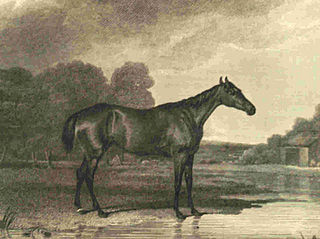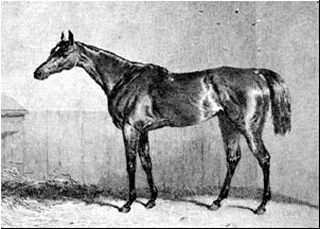Zinc (1820–1840) was a British Thoroughbred racehorse and broodmare, which in 1818 became the third filly to win both the 1000 Guineas at Newmarket Racecourse and the Oaks at Epsom Downs Racecourse. As a three-year-old in 1823 she won three of her five starts, with her defeats coming against the classic-winning colts Nicolo and Emilius. She won both her races in 1824 but failed to win as a five-year-old in 1825 and was retired from racing.
Zeal was a British Thoroughbred racehorse and broodmare, which won the eighth running of the classic 1000 Guineas. As a three-year-old in 1821 won she won her first three races at Newmarket Racecourse including the 1000 Guineas but then finished fourth in The Oaks. As a four-year-old she walked over in the valuable Port Stakes but was beaten in her only other race. She later had a successful career as a broodmare.
Arab (1824–1841) was a British Thoroughbred racehorse and broodmare. In a brief racing career, the filly ran three times with her only success coming in the classic 1000 Guineas at Newmarket in 1827.
Catgut was a British Thoroughbred racehorse and broodmare who won the classic 1000 Guineas at Newmarket in 1819. The Guineas was the filly's only competitive win in six races, her other victory coming when she was allowed to walk over on her racecourse debut.
Rowena was a British Thoroughbred racehorse and broodmare that won the classic 1000 Guineas at Newmarket in 1820. On her only other appearance, she finished second in the Oaks Stakes. She later became a successful broodmare.
Whizgig (1819–1840) was a British Thoroughbred racehorse and broodmare who won the classic 1000 Guineas at Newmarket in 1822. In a racing career which lasted from April 1822 until May 1824 she ran fourteen times and won seven races. Unraced as a two-year-old, Whizgig won six of her seven races in 1822, her only defeat coming in the Oaks Stakes. She remained in training for a further two seasons, but was less successful, winning only one more race. She later became a successful broodmare.
Tontine was a British Thoroughbred racehorse and broodmare who won the classic 1000 Guineas at Newmarket in 1825. When the other horses entered in the race were withdrawn, Tontine became the only horse to win a classic by walkover. In a racing career which lasted from April 1825 until April 1826 she ran eight times and won three races. Unlike many of her near relatives, Tontine made no impact as a broodmare.
Music was a British Thoroughbred racehorse and broodmare who won the classic Oaks Stakes at Epsom Downs Racecourse in 1813. Music's success in the Guineas was the only win in a seven race career and gave her owner George FitzRoy, 4th Duke of Grafton the first of twenty classic wins. Music was sold and exported to Ireland at the end of her three-year-old season.

Minuet (1812–1833) was a British Thoroughbred racehorse and broodmare who won the classic Oaks Stakes at Epsom Downs Racecourse in 1815. In a racing career which lasted from July 1814 until October 1817 she competed twenty-one times, winning nine races and being placed on a further ten occasions. On her only race in 1814, she won the July Stakes, one of the year's most important races for two-year-olds. In the following year she finished second in the 1000 Guineas on her debut and then won her next three races including the Oaks. Minuet stayed in training for two further seasons, winning five more races including a victory over a strong field in the all-aged Trial Stakes in September 1816. After her retirement from racing she had some success as a broodmare, breeding several winners.
Pastille was a British Thoroughbred racehorse and broodmare who won two British Classic Races. In a career which lasted from April 1822 until November 1824, she won eight of her thirteen races and was placed second or third in the other five. On her second racecourse appearance in she became the first filly to win the 2000 Guineas at Newmarket and went on to win the Oaks Stakes at Epsom Downs Racecourse a month later. She won once as a four-year-old in 1823 and was unbeaten in three starts in 1824. After her retirement from racing she had some success as a broodmare.

Oxygen was a British Thoroughbred racehorse and broodmare who won the classic Oaks Stakes at Epsom Downs Racecourse in 1831. In a racing career which lasted from July 1830 until April 1833 she won eight of her fifteen races and finished second on five occasions. Oxygen's Oaks was the last of twenty classic wins for her owner George FitzRoy, 4th Duke of Grafton.

Turquoise (1825–1846) was a British Thoroughbred racehorse and broodmare who won the classic Oaks Stakes at Epsom Downs Racecourse in 1828. In a racing career which lasted from April 1828 until April 1830 she ran eighteen times, winning eleven races and finishing second on five occasions. As a three-year-old in 1828 she failed to attract a bid after winning a claiming race at Newmarket but then created an upset by winning the Oaks at odds of 25/1. She went on to prove herself a leading stayer, winning three more races before the end of the season. In 1829 she won five more races including three walkovers when no horses appeared to challenge her. She was retired after a single unsuccessful run in 1830.
Charlotte was a British Thoroughbred racehorse and broodmare who won the inaugural running of the classic 1000 Guineas at Newmarket Racecourse in 1814. The Guineas was Charlotte's only race as a three-year-old but she returned to run four times in 1814. She won a Gold Cup at Stamford but was retired after being injured in a race at the same course a day later.

Cobweb (1821–1848) was an undefeated British Thoroughbred racehorse and who won two British Classic Races as a three-year-old and went on to become a highly successful broodmare. Cobweb's racing career consisted of three competitive races in the early part of 1824. After winning on her debut she claimed a second prize when her opponents were withdrawn by their owners. She then won the 1000 Guineas at Newmarket Racecourse and the Oaks Stakes at Epsom Downs Racecourse before being retired to stud.
Pelisse (1801–1810) was a British Thoroughbred racehorse who won the classic Oaks Stakes at Epsom Downs Racecourse in 1804. In a long racing career which lasted from April 1804 until April 1809 she had at least six different owners and ran thirty-five times, winning thirteen races and finishing second on eleven occasions. The Oaks was her second race and first win. In the succeeding years she competed at distances from five furlongs to four miles, racing mainly at Newmarket Racecourse, often in match races. She died in 1810, a year after being retired from racing.
Bronze was a British Thoroughbred racehorse and broodmare who won the classic Oaks Stakes at Epsom Downs Racecourse in 1806. Bronze's classic win left her unbeaten in three starts, but her subsequent racing career was undistinguished: in eighteen more races she recorded only three wins, two of which were at relatively minor tracks. After being retired to stud in 1809 she proved to be a highly successful and influential broodmare, whose direct descendants have won many important races up to the present day.
Morel was a British Thoroughbred racehorse and broodmare who won the classic Oaks Stakes at Epsom Downs Racecourse in 1808. In a racing career which lasted from April 1808 until July 1812 the mare ran twenty-seven times and won fourteen races. She was mainly campaigned at Newmarket Racecourse, running against some of the best horses of the era in match races and frequently carrying large weights in handicaps. Unlike many champions of the early 19th century, she was particularly effective at shorter distances, recording many of her successes over a mile or less. After her retirement from racing, Morel became a highly successful and influential broodmare, whose direct descendants have won numerous major races in Europe, North America, Japan and Australasia.

Medora (1811–1835) was a British Thoroughbred racehorse and broodmare who won the classic Oaks Stakes at Epsom Downs Racecourse in 1814. In a racing career which lasted from April 1814 to May 1816, she ran thirteen times, won four races, and twice "received forfeit" when her opponent did not appear for a scheduled match race. Unraced as a two-year-old, Medora produced her best form in the first half of 1814, she finished third in the inaugural 1000 Guineas, won the Oaks and then claimed two races at Royal Ascot. She remained in training for two more seasons but was less successful, winning only one competitive race. She was retired to stud where she became a highly successful and influential broodmare, whose direct descendants won many major races throughout the 19th and 20th centuries.

Memnon was a British Thoroughbred racehorse and sire best known for winning the classic St Leger Stakes in 1825. In a racing career which lasted from 1824 until 1828 he ran fifteen times and won nine races. Bred and originally trained in Yorkshire, he was unbeaten in two races as two-year-old in 1824, including the Champagne Stakes and won the York version of the St Leger the following spring. In the St Leger at Doncaster in September 1825, he was successful as the heavily backed favourite in a record field of thirty runners. Memnon was later trained at Newmarket and recorded his most important subsequent victory when winning the Ascot Gold Cup as a five-year-old in 1827. After standing as a breeding stallion for five years in England with moderate results, he was sold and exported to Russia.

Jerry was a British Thoroughbred racehorse and sire best known for winning the classic St Leger Stakes in 1824. In a racing career which lasted from 1824 until 1827 he ran ten times and won five races. Unraced as a two-year-old, he was beaten on his first appearance in 1824 but then won the York St Leger and the XYZ Stakes at Newcastle before defeating twenty-two opponents in the St Leger at Doncaster. Jerry missed the entire 1825 season and showed little form in 1826, but won twice as a six-year-old in 1827. He was retired to stud, where he proved to be a successful sire of winners.








